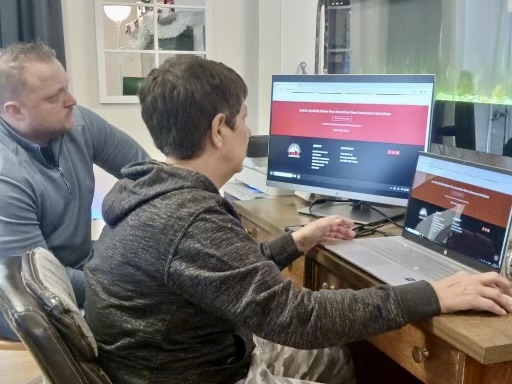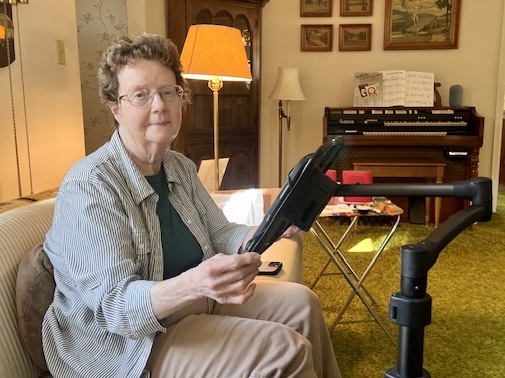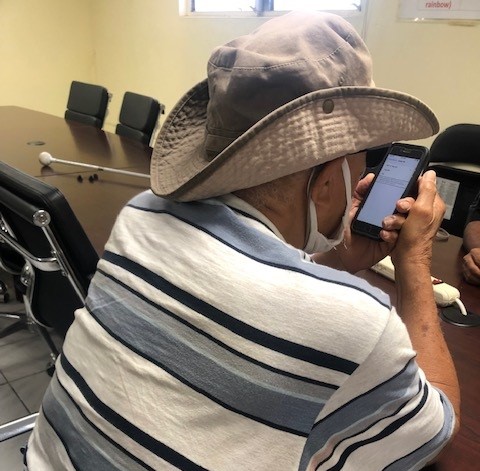By Deborah Kendrick, AccessWorld Magazine
When Helen Keller attended the now-famous Perkins School for the Blind, she was on the road to becoming a world-renowned writer, speaker, and defender of social justice. Clearly she was brilliant and talented, but the simple gift of communication, the relentless,frenzied spelling into the little girl’s hand, was the key that launched her on her path of remarkable achievement.
Today, there are an estimated one million Americans with combined vision and hearing loss sufficient to warrant deaf-blind status, and a new federal program holds the promise of providing them with a similar key to communication, 21st-century style.
The National Deaf-Blind Equipment Distribution Program (NDBEDP), a part of the Communication and Video Accessibility Act, became effective in July of 2012. Administered by the Federal Communications Commission, the pilot project allocates $10 million each year to provide telecommunications equipment and other technology that will connect individuals who are deaf-blind to a world of opportunities for connections to work, school, and social interaction.
Each of the 50 states has a single organization under contract to qualify, assess, and train individuals receiving equipment, many of them receiving assistance and advice from Perkins and the Helen Keller National Center.
To date, some 600 consumers are in the process of receiving assistance, and the numbers are growing. Given the nature of deaf-blindness, the hardest part may well be getting word to those who can reap the greatest benefit from the program.
The Perkins School for the Blind and the Helen Keller National Center have launched a campaign called iCanConnect in an attempt to spread the word and answer basic questions regarding the program.
Steven Rothstein, president of Perkins, believes that the promise of this legislation cannot be overstated. At present, in its pilot project stage, the program is in its infancy with FCC still making the rules and figuring out the best direction.
“When you take the long view,” Rothstein said, “I believe the program has the potential to make more of a difference for deaf-blind individuals than anything that has happened since Helen Keller was enrolled at our school.”
Equipment Covered by the Program
Some people who are deaf-blind are completely deaf and completely blind. Some have some usable vision, others have some usable hearing, most have their own unique blend of the two sensory disabilities. Consequently, the type of equipment that will connect a given individual to communication can vary considerably.
Essentially, any technology or telecommunications equipment that provides some link to communication and connections to the wider world is likely to be within the parameters of the NDBEDP. Specially designed products, such as signalers that flash or vibrate to indicate the ringing of a telephone, braille notetakers that connect to the Internet,and refreshable braille displays that connect to computers for e-mail and Internet access are eligible for the program. Similarly, laptop and desktop computers, oversized computer monitors that enable a person with extremely low vision to see content from the Internet or e-mail messages, or text-to-speech software that reads the screen aloud are all possibilities. Also on the list are a variety of mobile devices (such as smartphones), tablets, and PDAs that render communication and connection possible and offer accessibility features to individuals who have limited sight and hearing.
How the NDBEDP Can Help
Jorge Santos of Chicopee, MA, is one of the happy consumers who has been served by NDBEDP. He had worn powerful hearing aids since age four; his vision gradually declined as well. In 2000, he was finally diagnosed as having Type II Ushers Syndrome, a congenital disease that causes both hearing and vision loss. He attended the Helen Keller National Center for training and job assessment in 2003, where his aptitude for working with computers was recognized. Upon returning home, he enrolled in a certification course in a nearby community college and became a certified computer technician. He now works at a local Boys and Girls Club, maintaining computers, teaching kids to use them, and managing password protection and Internet safety.
Through the NDBEDP, Jorge now uses a Mac laptop, an iPad, and iPhone, and has a 27-inch computer monitor that enables him to control the large font and white-on-black contrast that he needs for reading web pages and e-mail. His iPhone is connected to a Bluetooth device that sends sound directly into his hearing aids.
“There was a time,” Jorge reflects, “when I was frustrated by things I couldn’t do any more. Now I just move on.”
For him, moving on has included connection to a local deaf-blind club, involvement in a local group of individuals who are visually impaired or blind who do community service projects, and serving as an appointed member to the consumer advisory board to the Massachusetts Commission for the Blind. His new equipment, he says, makes all of those pursuits along with his job and family life possible.
Eligibility for the NDBEDP
There are very specific guidelines for qualification for the program. First, not surprisingly, the application process requires a physician or other health care professional to document sufficient loss of both sight and hearing for the applicant to qualify as deaf-blind. Secondly, applicants must have proof of income placing them at or below 400 percent of the US poverty guidelines. In the continental US, individuals with annual income at or below $44,680, or families of four with an income at or below $92,200 are eligible. In Alaska, the threshold is $51,440 for an individual or $106,040 for a family of four. In Hawaii, an individual with an income up to $55,880 is eligible or $115,280 for a family of four.
How to Apply
The iCanConnect site provides contact and other information for the contracting organizations in every state. The site also provides a list of the wide array of equipment considered within the scope of the NDBEDP, and a downloadable brochure. For many individuals who have combined vision and hearing loss, learning about the project or accessing the web site may be the largest obstacle to submitting an application. Articles like this one, in other words, are a vital tool in spreading the word and finding the individuals who can benefit from the program. Many states have opted in to access information in a national database maintained by Perkinsin order to locate and reach out to individuals who may be eligible.
When applications are accepted, each individual is assessed to identify the most appropriate equipment, and training is provided.
Today’s world of telecommunications was certainly never imagined by Helen Keller or her peers. We know what she accomplished through far simpler tools than those available to us in the 21st century. Only time and the continued growth of this truly encouraging national program will reveal the productivity and contributions yet to be made by contemporary deaf-blind Americans.
For further information on the National Deaf-Blind Equipment Distribution Program or to locate a partnering program in your particular state, visit the iCan Connect site or call 800-825-4595.



